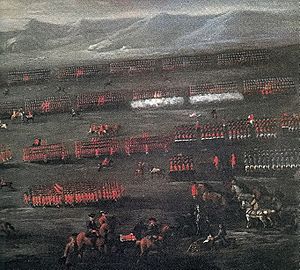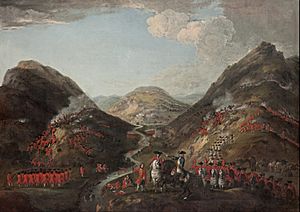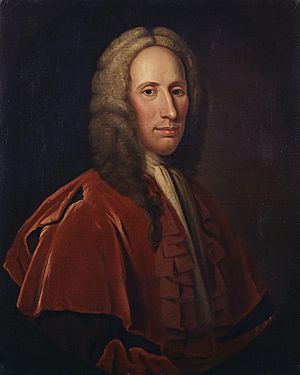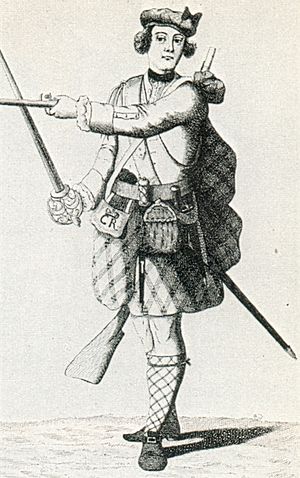Independent Highland Companies facts for kids
The Independent Highland Companies were special groups of soldiers from the Scottish clans in the Scottish Highlands. The British government created them between 1603 and 1760. Their main job was to help keep peace and enforce laws in the Highlands.
These companies were a bit like a local police force or a special militia. Their leaders were officially part of the British Army. However, the companies themselves were not regular army regiments. They were very important because they were the start of the famous Highland Regiments in the British Army. For example, ten of these companies came together in 1739 to form the Earl of Crawford's Highland Regiment, which later became the 42nd Regiment of Foot.
Contents
Early Independent Companies: Keeping Order in the Highlands
The first Independent Companies started around 1603, when James VI of Scotland also became James I of England. At this time, the Highlands were quite wild, and the government wanted to bring more order.
One of the first groups was called the "King's Guard." These were mounted soldiers who helped enforce laws. In 1605, they went to the Western Isles to make sure local chiefs paid their taxes. Later, in 1608, they tried again to bring royal authority to the area.
In 1624, important leaders met to discuss problems caused by clans like the Clan Gregor. These problems included stealing cattle and general lawlessness. They decided to choose two "Highland Captaincies" to help control the area. These were led by professional soldiers, which was a big change. This idea continued even after King James died in 1625.
During this time, many famous Highland robbers were active. The Independent Companies tried to keep things calm. However, their work seemed less important during the big battles of the Scottish Civil War (1644–1645). Even later, General George Monk had to use local clan groups to help keep peace. For instance, the Clan Cameron, who usually supported the King, even formed a company to help General Monk control the Clan MacDonell of Glengarry.
The Restoration Period: New Companies and Challenges
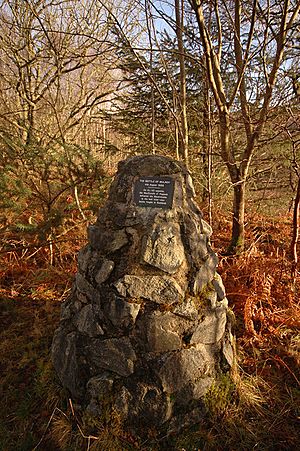
After King Charles II returned to the throne in 1660, he also created several Independent Highland Companies. In 1666, he allowed the Earl of Argyll to form a company of 60 men for one year to protect his lands. The next year, the Earl of Atholl was allowed to raise a force to keep peace in the Highlands.
Over the next 70 years, many Independent Highland Companies were formed and then later disbanded. This depended on the political and military needs of the time. Some commanders, like the Earl of Argyll, used these companies mostly for their own purposes.
King Charles later decided he could not afford these companies. So, two of them joined a regular army regiment, the 21st Foot. These companies were led by Captain Kenneth Mackenzie of Suddie and Alexander Cairnes. Kenneth Mackenzie of Suddie was later killed in 1688 at the Battle of Mulroy. He was leading his company to support the Clan Mackintosh against the Clan MacDonald of Keppoch and the Clan Cameron.
After this battle, King James II (VII of Scotland) wanted to bring peace to both the Highlands and Lowlands. He asked the main clan chiefs to provide soldiers. Here is a list of how many men each chief was asked to provide:
| Commander | Soldiers | Lieutenants | Ensigns | Sergeants | Pipers |
|---|---|---|---|---|---|
| John Murray 2nd Earl of Atholl | 200 | 4 | 4 | 8 | 4 |
| James Drummond, 4th Earl of Perth | 50 | 1 | 1 | 2 | 1 |
| Laird of Weem (Clan Menzies) |
50 | 1 | 1 | 2 | 1 |
| Laird of Gairntullie (Stuart) | 50 | 1 | 1 | 1 | 1 |
| John Campbell, 1st Earl of Breadalbane and Holland | 100 | 2 | 2 | 4 | 2 |
| Clan Robertson and Clan MacFarlane | 48 | 1 | 1 | 2 | 1 |
| James Graham, 4th Marquess of Montrose | 20 | 1 | - | 1 | - |
| William Graham, 8th Earl of Menteith | 50 | - | 1 | 1 | 1 |
| Alexander Stuart, 5th Earl of Moray | 25 | - | 1 | - | - |
| Earl of Mar | 100 | 1 | 1 | 2 | 1 |
| George Gordon, 1st Duke of Gordon | (unknown) | - | - | - | - |
| Colonel Patricke Grahame | (unknown) | - | - | - | - |
The time between 1660 and 1688 was very unsettled in the Scottish Highlands. Many people lost their land and had to turn to a life of lawlessness. The Independent Companies helped keep some order. However, they were never fully supported by the government. The government often switched between using these companies and relying on the clans themselves. The companies were also not large enough to handle all the strong rivalries between clans. Still, they were a good start, as they were paid soldiers who dressed like locals and spoke the same language as the clansmen.
The Revolution Period: New Kings and Battles
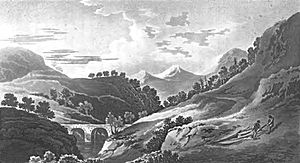
In 1688, England and Scotland replaced King James II (VII of Scotland) with William III of Orange. This event was called the Glorious Revolution. In 1689, a rebellion started to bring James back to the throne. This was led by John Graham, 1st Viscount Dundee, who gathered about 1000 men from Highland clans like Clan Cameron and Clan MacDonald of Keppoch.
They faced General Hugh Mackay, who was also a Highlander. Mackay had experienced soldiers from the Dutch army. He also had support from an Independent Highland Company of the Clan Menzies, led by Captain Robert Menzies. At the Battle of Killiecrankie, Mackay's forces were defeated. However, the Menzies Independent Company later helped defeat the rebels at the Battle of Cromdale in 1690.
Soldiers from England and the Scottish Lowlands often did not like serving in the Highlands. Because of this, five new Independent Highland Companies were created starting in 1691. These companies were used until 1694 and worked alongside regular army units.
The 18th Century: Continued Challenges and the Black Watch
At the start of the 1700s, the clan system was divided. Some clans supported the old royal family (Jacobites), while others supported the new government (Whigs). Lawlessness was still a big problem. Many clans thought it was acceptable to steal cattle. Sometimes, due to bad harvests, crime became more serious, with people being kidnapped or attacked.
To deal with this, two Independent Highland Companies were formed in 1701. One was from Clan Campbell, and the other from Clan Grant. Their job was to help courts stop thefts and catch criminals. However, these companies were not large enough to control all the widespread trouble.
The Earl of Tullibardine offered to raise a company of 800 men. But he said he would not allow anyone named Campbell to join, so his offer was refused. A third company of about 50 men was eventually formed in 1704, led by Duncan Mackenzie. These three companies were active until 1707, when England and Scotland officially united. The union did not change how the companies were paid. They continued to help keep peace and prevent people from joining the Jacobite cause.
In 1708, Fraser, Lord Lovat, said that the companies had managed to control most of the robberies. In 1707, the Grant Independent Company was ordered to watch the coast for a possible landing by James Stuart, who claimed the British throne. When he didn't land, they went back to their normal duties.
Jacobite Rising of 1715
By 1715, the Independent Highland Companies were led by Colonels Campbell, Grant, and Munro. It's not fully clear how much they fought in the 1715 rebellion. However, there are stories that parts of the Grant and Munro companies fought at the Battle of Sheriffmuir.
It is clear that they played an active role before and after the battle. Colonel Sir Robert Munro, 6th Baronet was governor of Inverness for a while. He made the rebel Mackenzies give up their weapons. Munro, along with soldiers from the Grants, Rosses, and Mackays, also forced the Earl of Seaforth to surrender. Colonel Grant helped by setting up a military post at Brahan and capturing Gordon Castle. Colonel Sir Robert Munro and his brother Captain George Munro of Culcairn also collected weapons at Blair Atholl. The Grant company disarmed clansmen in Ruthven.
Jacobite Rising of 1719
After 1717, the Independent Highland Companies were reduced in size. Regular troops were left to keep security in the Highlands. These troops were stationed at places like Fort William. Highland soldiers were mixed with regular troops to act as guides and keep peace.
In 1719, James Stuart gained support from Spain. About 330 Spanish soldiers came to Scotland. They joined clans like the Clan Cameron and Clan Gregor (under Rob Roy MacGregor). They faced government forces led by Major-General Wightman. He had 850 regular soldiers, 120 dragoons, and some quickly gathered Independent Company men from the Clan Grant and Clan Munro.
The Munros were very loyal to the government. Their Independent Company, led by George Munro of Culcairn, guided the government forces through the mountains. The Battle of Glen Shiel happened on June 10, 1719. It lasted three hours. The government's superior firepower and the aggressive actions of the Munros helped them win. The Munro Independent Company showed how important it was to know the land and fight effectively.
Aftermath
In 1724, Simon Fraser, 11th Lord Lovat, wrote to King George I. He said that disbanding the Independent Highland Companies in 1717 had made the Highlands lawless again. He also said that the Disarming Act of 1716 had left loyal clans almost defenseless. While loyal clans followed the act, Jacobite clans often ignored it or handed in old, useless weapons.
In 1725, Field Marshal George Wade was put in charge of forces in North Britain. He was told to bring back the Independent Highland Companies. King George I ordered six companies to be raised, which happened by 1729. The first three companies had 100 men each. The next three had 75 men each. Wade made the companies more disciplined and trained them better. He warned the captains that any financial problems would be dealt with strictly.
Formation of the Earl of Crawford's Highland Regiment
In 1738, Wade reviewed the six Independent Highland Companies. By this time, they were known as Am Freiceadan Dubh, which means Black Watch. This name might have come from their dark uniforms, which were different from the "Red Soldiers" of the Lowlands and England.
In 1739, four more companies were added. All ten companies then joined together to form the Earl of Crawford's "Highland Regiment." This regiment was numbered 43rd in the army line, and later became the 42nd Regiment of Foot.
Jacobite Rising of 1745
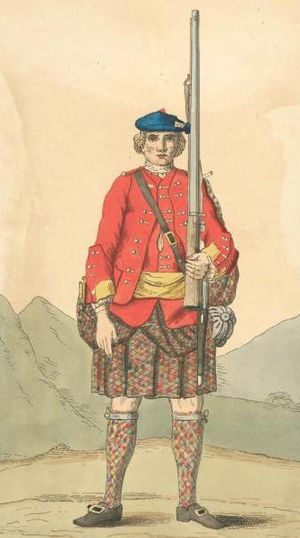
In September 1745, Duncan Forbes, Lord Culloden, who supported the government, was asked to raise twenty new Independent Highland Companies. These companies were meant to fight against the Jacobite rising of 1745. He managed to raise eighteen companies. The men came from the clans of their commanders. Many clansmen, even if not directly related to their chief, would use the chief's family name. For example, in George Munro of Culcairn’s company in 1745, 59 out of 93 men were named Munro.
The table below lists the commanders of these 18 Independent Highland Companies. This list does not include regular army regiments like Loudon's Highlanders or the Earl of Crawford's Highland Regiment, which also had Highland soldiers. These semi-professional independent companies are sometimes confused with less organized local militia groups that also supported the government.
List of Independent Companies raised 1745–46
| Clan | Captain | Lieutenant | Ensign | Date of completion |
|---|---|---|---|---|
| Clan Munro | George Munro | Adam Gordon | Hugh Monro | 23 October 1745 |
| Clan Sutherland (1st company) |
Alexander Gunn | John Gordon | Kenneth Sutherland | 25 October 1745 |
| Clan Grant | Patrick Grant | William Grant | James Grant | 3 November 1745 |
| Clan Mackay (1st company) |
George Mackay | John Mackay | James Mackay | 4 November 1745 |
| Clan Sutherland (2nd company) |
Peter (or Patrick) Sutherland | William Mackay | John Mackay | 8 November 1745 |
| Clan MacLeod (1st company) |
John MacLeod | Alexander MacLeod | John MacAskill | 15 November 1745 |
| Clan MacLeod (2nd company) |
Norman MacLeod | Donald MacLeod | John MacLeod | 15 November 1745 |
| Clan MacLeod (3rd company) |
Norman MacLeod | John Campbell | John MacLeod | 15 November 1745 |
| Clan MacLeod (4th company) |
Donald MacDonald | William MacLeod | John MacLeod | 15 November 1745 |
| Town of Inverness | William Mackintosh | Kenneth Mathisom | William Ballie | 18 November 1745 |
| Clan MacLeod of Assynt | Hugh MacLeod (of Geanies) |
George Monro | Roderick MacLeod | 28 November 1745 |
| Clan Mackenzie (1st company) |
Alexander Mackenzie | John Mathison | Simon Morchison | 10 December 1745 |
| Clan Mackenzie (2nd company) |
Colin Mackenzie | Alexander Campbell | John Mackcrae | 10 December 1745 |
| Clan Macdonald of Sleat (1st company) |
James MacDonald | Allan MacDonald | James MacDonald | 31 December 1745 |
| Clan Macdonald of Sleat (2nd company) |
John MacDonald | Allan MacDonald | Donald MacDonald | 31 December 1745 |
| Clan Mackay (2nd company) |
Hugh Mackay | John Mackay | Angus Mackay | 6 January 1746 |
| Clan Ross | William Ross | Charles Ross | David Ross | 8 January 1746 |
| Clan Mackenzie (3rd company) |
Colin Mackenzie | Donald Mackenzie | Kenneth Mackenzie | 2 February 1746 |
The 1745 Campaign
Raising these companies was tricky. The Secretary of War wanted three companies from the Clan Munro because of their loyalty. But Forbes only raised one Munro company. Instead, he raised three from the Clan Mackenzie and four from the Clan MacLeod of Skye. These two clans had supported the Jacobites before but now showed loyalty to the government. The Clan Sinclair had Jacobite sympathies, so they were not offered a company.
The Independent Highland Companies played a very active part in the 1745 Jacobite rising. One of their first actions was when 600 men from the Grant, Sutherland, Munro, and Mackay companies fought in the Siege of Fort Augustus (December 1745). They freed the fort from the Clan Fraser of Lovat, who were mostly Jacobites by then. Simon Fraser, 11th Lord Lovat had lost his Fraser Independent Company in 1740. He later said this was why he joined the Jacobites.
On December 23, 1745, Norman MacLeod, chief of the Clan MacLeod, led 500 men from the MacLeod Independent Highland Companies at the Battle of Inverurie (1745). They were defeated by a larger Jacobite force. The next February, the Siege of Inverness (1746) happened. The Grant and Ross Independent Highland Companies surrendered Inverness Castle to a larger Jacobite force.
On March 20, 1746, Loudon's Highlanders regiment and the MacLeod Independent Highland Companies were surprised and defeated by a Jacobite attack at Dornoch. 300 of Loudon's regiment were captured. But most, about 900, escaped to the Isle of Skye. This group included their commanders: John Campbell, 4th Earl of Loudoun, Duncan Forbes, Lord Culloden, and Norman MacLeod. They were joined by Alexander MacDonald of Sleat and the 3rd Mackenzie Independent Company, bringing their total to 1300 men. Other Loudon's regiment soldiers escaped to the lands of the Mackays in the far north.
On March 25, 1746, the 1st Mackay Independent Company (under Captain George Mackay), the 2nd Mackay Independent Company (under Captain Hugh Mackay), one of the Sutherland Companies, and some Loudon's Highlanders had a big success at the Skirmish of Tongue. They captured money and supplies meant for the Jacobites from a French ship. They also took 156 Jacobites prisoner.
In response, the Jacobite leader, Charles Edward Stuart, sent a large force north. But they arrived too late. They were surprised by the 2nd Sutherland Company (under Ensign John Mackay) and the 2nd Mackay Company. This was called the Battle of Littleferry. The Jacobite force was completely defeated, losing about 100 men. This defeat prevented them from helping the Jacobites at the Battle of Culloden the next day.

On April 14, 1746, two days before the Battle of Culloden, the Munro Independent Company and the 1st Sutherland Independent Company joined Prince William, Duke of Cumberland at Nairn. These two companies had been fighting groups of Highlanders trying to join Prince Charlie.
During the Battle of Culloden on April 16, the Independent Highland Companies (1st Sutherland) were kept in reserve. The Munro company had already gone back north. Eight companies of other Highland infantry did fight for the government at Culloden. These included four from the Campbell of Argyll Militia, three from Loudon's Highlanders, and one from the Earl of Crawford's Highland Regiment. Some reports say a small group of Independent Highland Companies joined the Argyll militia. They fired their muskets with great effect on the side of the Jacobite army.
After the Battle of Culloden, some MacLeod and MacDonald Independent Highland Companies were sent to capture Prince Charlie. But they failed to find him. It was later said they weren't too eager to find him. Much of the "mopping up" after Culloden was left to the Argyll militia and the Independent Companies. Some reports say they were harsh on their own relatives and fellow clansmen. However, other reports say the Independent Companies did not want to crush the rebellion further. By June 1746, the Independent Highland Companies were much smaller. Within six months after Culloden, they were completely disbanded.
The 1760s: End of an Era
In 1760, five new Independent Highland Companies were formed. They were trained in Perth until late 1761. Then, they joined the Keith and Campbell Highlanders regiment. In 1762, another Highland regiment of 600 men was raised. It was called the 101st Johnstone Highlanders. It was supposed to go to Portugal to fight, but peace talks stopped this.
During the Seven Years’ War, some other Independent Highland Companies were formed. But they were quickly sent south to join the British Army as new recruits. They were more like a way to recruit soldiers than true independent companies. No more Independent Highland Companies were formed after 1763. However, from these early companies came the famous Highland regiments that became known worldwide later in the 18th century.
See also
- 43rd Regiment of Foot - formed from the ten Independent Highland Companies (Black Watch) in 1739 and renumbered the 42nd in 1748.
- Black Watch (Royal Highland Regiment) - regiment formed in 1881 from the 42nd/43rd Highlanders Regiment until 2006.
- Black Watch - the 3rd Battalion of the Royal Regiment of Scotland formed in 2006.
- Loudon's Highlanders - Highland regiment formed in the 18th century.
- John Campbell, 4th Earl of Loudoun - founder of the above regiment.
- Duncan Forbes, Lord Culloden - responsible for raising Independent Highland Companies in 1745 - 1746.
- Scottish clan - Kinship groups from which the men of the Independent Highland Companies were drawn from.
- Privy Council of Scotland - advisory body to the king that was responsible for raising the early Independent Highland Companies.
- Campbell of Argyll Militia - similar militia unit raised in the south-west Scottish Highlands.


